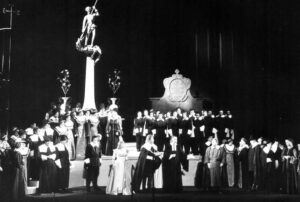
Opera Profile: Paul Hindemith’s ‘Die Harmonie der Welt’
By John VandevertDie Harmonie der Welt is the ninth opera composed by 20th-century German composer Paul Hindemith. Known for his work in developing and popularizing the compositional philosophy known as New Objectivity, Hindemith’s music was both tonal and not tonal. Exploring the limitations and extensions of traditional musical systems, thanks to the serialism of Arnold Schoenberg, composers were now open towards expressing themselves in elaborate ways.
The opera was completed in 1957 and shares the same name with another work of Hindemith’s, notably, the “Die Harmonie der Welt Symphony” (The Harmony of the World Symphony) composed in 1951 as a tasting of his future opera. Hindemith’s fascination with Kepler led him to translate some of Kepler’s earlier works (“Moon Dream”), and eventually using Kepler’s theorization on harmony as the foundation to his musical writing.
The opera’s main source of inspiration is the 1619 book entitled “Harmonices Mundi” (Harmonies of the World), written by astronomer Johannes Kepler. Arguing in five chapters, Kepler shows how the geometrical construction of the world around us, the stars, and the planets have harmonic relationships which can be explained as proof of the existence of a Godly force. Inspired by the mathematical-philosophical writing of Ptolemy in his work, “Harmonica,” written to show the relationship between ratios and harmonics, Kepler’s theorization argued that the orbital paths of the planets had Earth-bound significance on the nature of musical harmony. Rejecting the standardized system of Pythagorean tuning, tuning based on the perfect fifth and octave ratios, Kepler’s system was built around the Grecian concept of “Musica universalis.” He wanted to show how the natural world, the celestial world, and our own bodies all contribute to unique harmonic languages which all resonate with and through each other.
Hindemith had become interested in Mahler when he was a student at Yale. Musically, the musical planning seemed to have begun with his symphony, beginning in 1939, and soon in 1951 the opera began to be conceptualize through the symphony. However, in 1941 Hindemith’s motet In Principio erat Verbum had included music which would later be featured in the opera.
By 1956, although taking a considerable amount of effort, Hindemith finished the libretto and quickly finished the musical score. Once the opera was finished, Hindemith had noted that his opera was a biographical look at Kepler. As he wrote, “They are about the life and work of Johannes Kepler,” specifically the astronomer’s experiences while in appointment as the imperial mathematician in the court of Emperor Rudolf II and then towards his dramatic end of life. The main objective of Hindemith’s opera, as explained by him, was to document Kepler’s “search for the harmony that undoubtedly governs the universe.”
In 1957, the opera was successfully premiered at the Munich State Opera. Although not as widely performed now, its presence has continued well into the 21st-century and in 2017 the opera was performed at the Linz State Theatre.
Listen
Categories
Opera Wiki

